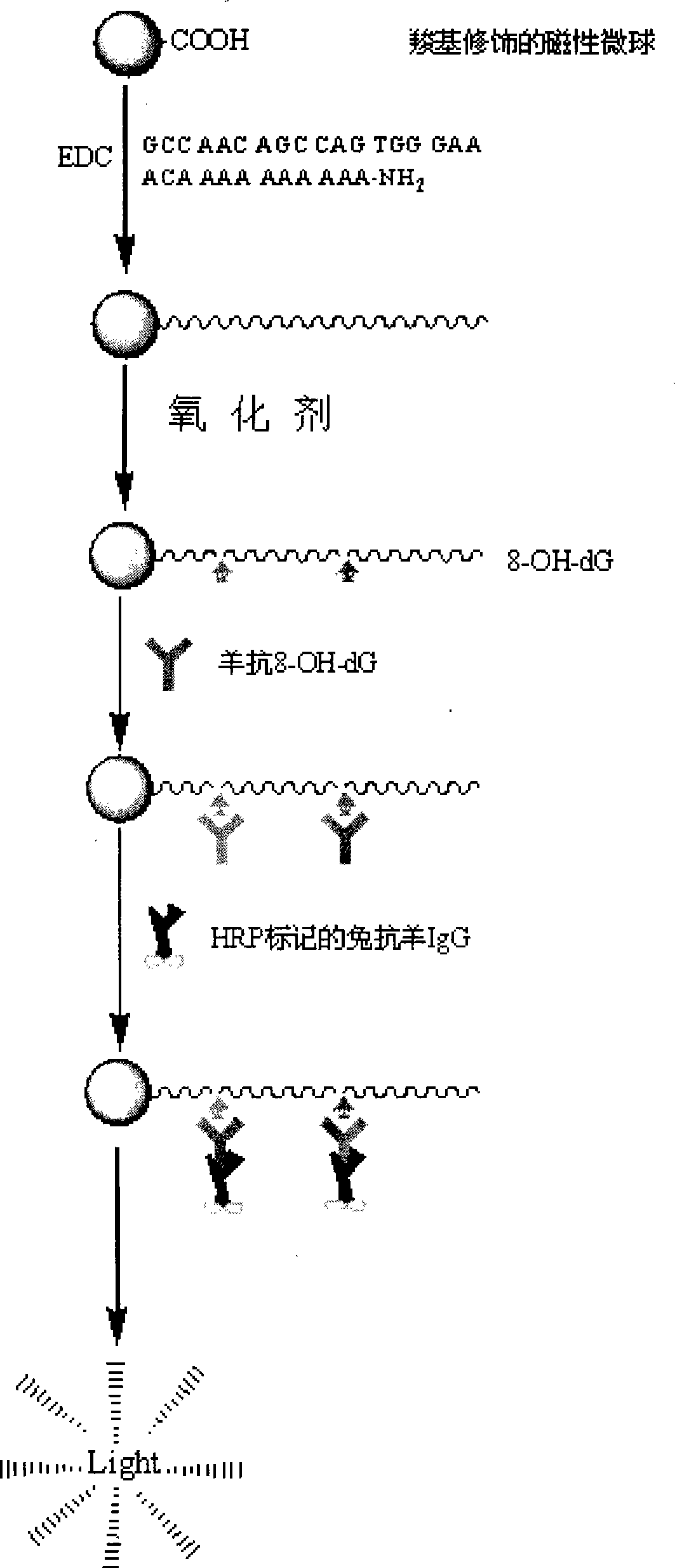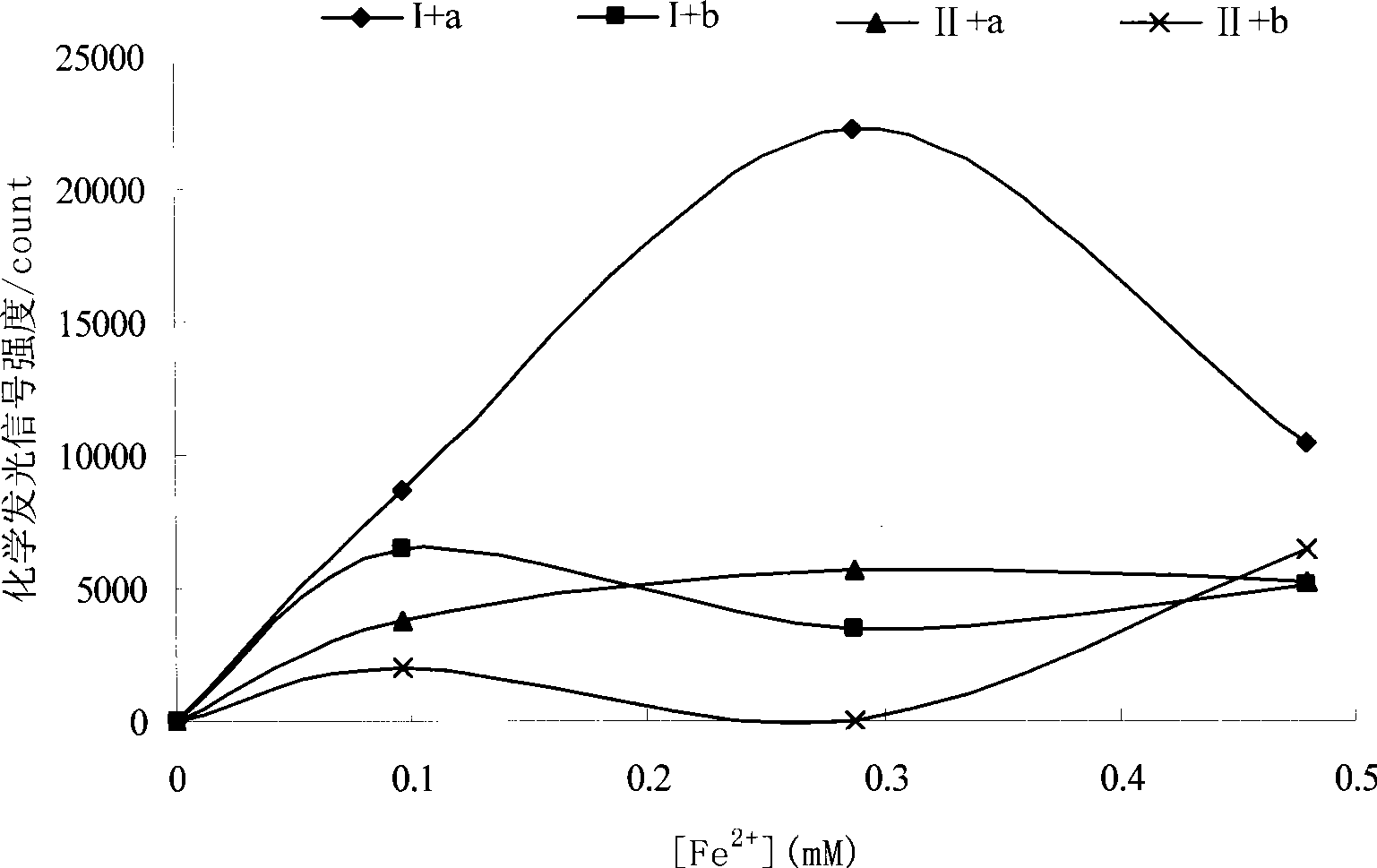Method for evaluating protective action of Chinese herbal medicine to DNA oxidation damnify
A technology of oxidative damage and protection, applied in the direction of biochemical equipment and methods, microbial determination/inspection, measurement devices, etc., can solve the problems of lung fibroblast DNA oxidative damage and so on
- Summary
- Abstract
- Description
- Claims
- Application Information
AI Technical Summary
Problems solved by technology
Method used
Image
Examples
Embodiment 1
[0030] Example 1 Determination of DNA Oxidative Damage Caused by Fenton's Reagent
[0031] 1. Reagents and instruments:
[0032] All reagents were of analytical grade, and the experimental water was deionized ultrapure water. Imidazole buffer at pH 6.0; 0.1M PBS, pH=7.2-7.4; washing solution is PBS containing 0.1% Tween 20; blocking solution I is 40mM glycine, 1% BSA imidazole buffer; blocking solution II 10% BSA in PBS.
[0033] N-(3-dimethylaminopropyl)-N'-ethyl-carbodiimide hydrochloride (EDC) was purchased from Sigma; HRP-labeled rabbit anti-goat IgG was purchased from Beijing Boaosen Biotechnology Co., Ltd. Goat anti-8-OH-dG was purchased from abcam company; HRP chemiluminescence kit was purchased from Milipore company; carboxy-modified magnetic microspheres (1.5 μm, Bangs Laboratories, Inc.); DNA (5'-GCC AAC AGC CAG TGG GAA ACA AAAAAAAAA-NH 2 -3'), synthesized by Shanghai Yingjun Biotechnology Co., Ltd. Oxidizing agent: FeCl 2 Aqueous solution (containing 0.04% HCl...
Embodiment 2
[0040] Example 2 Selection of Goat Anti-8-OH-dG Dilution
[0041] Since the goat anti-8-OH-dG used in the experiment has a strong activity and has a great influence on the detection signal, it is necessary to select an appropriate dilution concentration to obtain the optimal signal-to-noise ratio. figure 2 The effect of different dilutions on the detected signal intensity is shown. The experimental conditions are: Fe 2+ The concentration is 0.288mM, H 2 o 2 The dilution of HRP-labeled rabbit anti-goat IgG is 1 / 20000. Such as Figure 4 It can be seen that as the dilution of goat anti-8-OH-dG increases, the detection signal shows a trend of first increasing and then decreasing, and reaches the maximum value near the dilution of 100000 times. If the dilution is too large and the concentration is too high, the probability of non-specific adsorption of the antibody in the control group on the magnetic beads will increase; if the dilution concentration is too small, the concen...
Embodiment 3
[0042] Example 3 Different Fe 2+ The effect of concentration on the intensity of chemiluminescence
[0043] Fenton's reagent that can generate hydroxyl radicals (ie Fe 2+ Mediated H 2 o 2 ) is a relatively classic DNA damage oxidant, where Fe 2+ The concentration has a significant effect on the amount of 8-OH-dG produced, image 3 show different Fe 2+ The influence of concentration on the luminous intensity can be seen from the figure, with Fe 2+ As the concentration increases, the amount of 8-OH-dG produced also increases, and then decreases. It may be that excessive oxidants can cause DNA strand breaks, thereby reducing the amount of 8-OH-dG produced. Our detection Methodological studies of this effect have also shown results similar to those in the literature. In the experiment, I represents the 20,000-fold dilution of HRP-labeled rabbit anti-goat IgG, II represents the 40,000-fold dilution; a represents the 100,000-fold dilution of the goat anti-8-OH-dG, and b repre...
PUM
 Login to View More
Login to View More Abstract
Description
Claims
Application Information
 Login to View More
Login to View More - R&D
- Intellectual Property
- Life Sciences
- Materials
- Tech Scout
- Unparalleled Data Quality
- Higher Quality Content
- 60% Fewer Hallucinations
Browse by: Latest US Patents, China's latest patents, Technical Efficacy Thesaurus, Application Domain, Technology Topic, Popular Technical Reports.
© 2025 PatSnap. All rights reserved.Legal|Privacy policy|Modern Slavery Act Transparency Statement|Sitemap|About US| Contact US: help@patsnap.com



